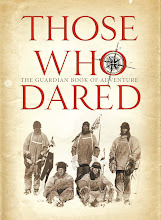Fakes and cheats, a recent posting on Mikael Strandberg's blog looks at why some explorers and mountaineers feel the pressure to lie about their exploits. As he points out, there is nothing new about this and inevitably the name of Frederick Cook crops up. In the early 20th century Cook claimed to have been the first to the North Pole and the first to climb on Mount Mckinley (Denali) although it is generally accepted that he didn't succeed at either. As an aside, Strandberg offers a link to someone who suggests that in fact the American might just have been the first up McKinley.
Some of the most famous cases of cheating can be found in Great Exploration Hoaxes by David Roberts. However, while reading the blog I was reminded of Like Water and Like Wind, another piece of work by Roberts. This is a novella about a climber who, after watching his partner fall to his death while descending a mountain face, returns to civilisation and tells the world they were the first up a spectacularly hard route. No one knows that they didn't actually make it to the top and the climber is hailed as a hero in the mountaineering community. Wealth and fame follow. Living a lie though has a corrosive effect on the protagonist and when some begin to question his claims he turns to drink and withdraws from climbing. There's much, much more to this fascinating tale as Roberts explores what motivates an individual to deceive both colleagues and themselves.
A copy of the story can be found in the excellent One Step in the Clouds, an anthology of mountaineering novels and short stories.













